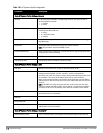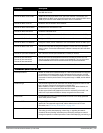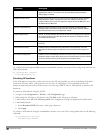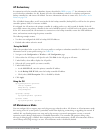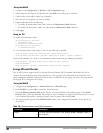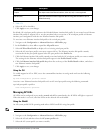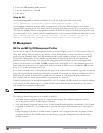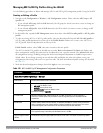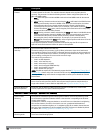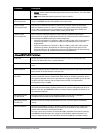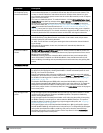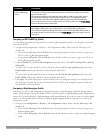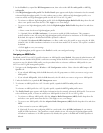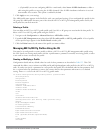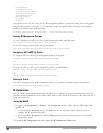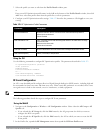
426 | AccessPoints(APs) DellPowerConnectW-SeriesArubaOS6.2 | User Guide
Parameter Description
Channel Transmit channel for this radio. The available channels depend on the regulatory domain
(country). This parameter includes the following channel number configuration options for 20
MHz and 40 MHz modes:
l none: Select this option to disable 40 MHz mode and activate 20 MHz mode for the entered
channel.
l above: Entering a channel number and selecting the above radio button in the WebUI selects
a primary and secondary channel for 40 MHz mode. When you use this option, the number
entered becomes the primary channel and the secondary channel is determined by
increasing the primary channel number by 4. For example, if you entered 157 into the Channel
field and selected the above option, radios using that profile would select 157 as the primary
channel and 161 as the secondary channel.
l below: Entering a channel number and selecting the below radio button in the WebUI selects
a primary and secondary channel for 40 MHz mode. When you use this option, the number
entered becomes the primary channel and the secondary channel is determined by
decreasing the primary channel number by 4. For example, if you entered 157 into the
Channel field and selected the below option, radios using that profile would select 157 as the
primary channel and 153 as the secondary channel.
If you select the spectrum monitoring checkbox on this profile page, the AP will operate as a
hybrid AP and scan the selected channel for spectrum analysis data.
Non 802.11 Interference
Immunity
Set a value for 802.11 Interference Immunity.
The default setting for this parameter is level 2. When performance drops due to interference
from non-802.11 interferers (such as DECT or Bluetooth devices), the level can be increased up to
level 5 for improved performance. However, increasing the level makes the AP slightly “deaf” to
its surroundings, causing the AP to lose a small amount of range.
The levels for this parameter are:
l Level 0: no ANI adaptation.
l Level 1: noise immunity only.
l Level 2: noise and spur immunity.
l Level 3: level 2 and weak OFDM immunity.
l Level 4: level 3 and FIR immunity.
l Level 5: disable PHY reporting.
NOTE: Only 802.11n-capable APs simultaneously support both the RX Sensitivity Tuning Based
Channel Reuse feature and a level-3 to level-5 Noise Immunity setting. Do not raise the noise
immunity default setting on APs that do not support 802.11n unless you first disable the Channel
Reuse feature.
Spectrum Monitoring Select this option to convert APs using this radio profile to a hybrid APs that will continue to
serve clients as an Access Point, but will also scan and analyze spectrum analysis data for a
single radio channel. For more details on hybrid APs, see "Spectrum Analysis" on page 570.
Advertise 802.11d and
802.11h Capabilities
Enable the radio to advertise its 802.11d (Country Information) and 802.11h (Transmit Power
Control) capabilities. This option is disabled by default.
Basic 802.11a/802.11g Settings — Spectrum Load Balancing
Spectrum load
balancing
The Spectrum Load Balancing feature helps optimize network resources by balancing clients
across channels, regardless of whether the AP or the controller is responding to the wireless
clients' probe requests.
If enabled, the controller compares whether or not an AP has more clients than its neighboring
APs on other channels. If an AP’s client load is at or over a predetermined threshold as
compared to its immediate neighbors, or if a neighboring Dell AP on another channel does not
have any clients, load balancing will be enabled on that AP. This feature is disabled by default.
For details, see "Enabling Spectrum Load Balancing" on page 359.
Spectrum load
balancing mode
The spectrum load balancing mode allows you to allows control over how to balance clients.
Select one of the following options:



